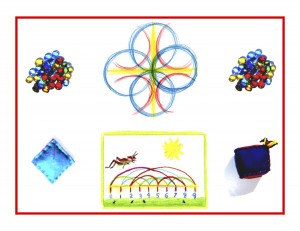Day 127
For one year, 365 days, this blog will address the Common Core Standards from the perspective of creating an alternate, ambient learning environment for math. Ambient is defined as “existing or present on all sides, an all-encompassing atmosphere.” And ambient music is defined as: “Quiet and relaxing with melodies that repeat many times.
Why ambient? A math teaching style that’s whole and all encompassing, with themes that repeat many times through the years, is most likely to be effective and successful. Today’s post will feature the next Grade 2 Common Core Math Standard listed in blue, followed by its ambient counterpart as practiced by Waldorf Education and Math By Hand.
Operations and Algebraic Thinking 2.OA
Work with equal groups of objects to gain foundations for multiplication.
3. Determine whether a group of objects (up to 20) has an odd or even number of members, e.g., by pairing objects or counting them by 2’s; write an equation to express an even number as a sum of equal addends.
Multiplication is learned alongside addition, subtraction, and division in Grade 1. So there’s no need to gain a foundation for multiplication since it’s been established from the beginning. Knowing the times tables is an indispensable essential that needs to be firmly in place by the middle of Grade 3. Waldorf and Math By Hand introduce long multiplication and division mid-Grade 3, and fractions at the beginning of Grade 4. These and all other math functions cannot be learned successfully without total times tables fluency.
For this reason, regular practice with the 2, 5, and 10 times tables through movement, games, art, singing, and patterns begins early on in Grade 1. Math By Hand Grade 2 begins with an intensive times tables block. One of the first projects is the construction of an oversized, colorful wall chart of all 12 tables. A simple folding exercise with large poster paper yields 144 folded squares. The children fill in all the rows they know: 1, 2, 5, and 10, then learn that since 11 is just double numbers, that row can be filled in as well. It’s empowering to see so much of the chart completed! Then a reference chart is used to help fill in the rest.
Counting by 2’s has been happening for a while now, and when multiplication and addition were compared in Grade 1, the relationship between the two made it apparent that 2 times any number would look the same as adding those same numbers (including showing how an even number is a sum of equal addends). Glass gems or other manipulatives were used to show this, then after seeing the equations concretely in this way, they were written as a last step in the process. Of course this continues in Grade 2 as a review, before moving on to addition and multiplication with regrouping.
Knowledge ensues in an environment dedicated to imaginative, creative knowing, where student and teacher alike surrender to the ensuing of knowledge as a worthy goal. Tune in tomorrow for more Common Core, along with its ambient, Waldorf/Math By Hand counterpart.












